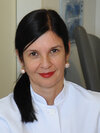History
The Beginnings of Radiotherapy
On 8 November 1895, physicist Wilhelm Conrad Röntgen made a revolutionary discovery at the Institute of Physics of the University of Würzburg: a new kind of radiation, which he called X-rays. They made it possible to glance inside the body, thus opening up entirely new diagnostic possibilities. It was only two weeks later that the first Roentgen image in history was taken: after an exposure time of 20 minutes, the bones of his wife’s hand were displayed.

In 1896, French physicist Antoine Henri Becquerel discovered that uranium salts emit a radiation beyond the range of visible light. This radiation arises when unstable atomic nuclei disintegrate, thereby emitting rays.

The scientific activity of Marie Skłodowska Curie focused on exploring radioactive substances: she researched the radiation of uranium compounds as previously noticed by Henri Becquerel. Together with her husband Pierre Curie she discovered the chemical elements polonium and radium. With the frequent use of radium in medicine, exact and comparable measurements were required. An international commission for the radium standard decided that the measuring unit for radioactive emissions should be named curie.

At first, radioactive substances were applied for diagnostic purposes, such as detecting thyroid disorders. From the beginning of the twentieth century onwards they were also used in therapy, e.g. being applied directly in the uterus to treat gynecological tumours. Scientists were fascinated and enthusiastic with the new radiation. Just one year after their discovery, Roentgen rays were applied in the treatment of skin alterations: radiologist Leopold Freund from Vienna irradiated a haired birthmark on the back of an eight year old girl, thereby permanently removing the birthmark. By the beginning of the twentieth century, radiation became an increasingly common method in the treatment of cancer, especially leukemia, which rendered noticeable successes even with small doses of radiation.
History of Radiotherapy at the Medical Center - University of Freiburg
The tradition of radiation therapy at the Medical Center - University of Freiburg dates back to 1896. This was the year when physicist Ludwig Zehnder, who collaborated with Wilhelm Conrad Röntgen, conducted the first research studies with X-rays in Freiburg. First experience with the use of X-rays in diagnostics and therapy were acquired in the Surgical Clinic and the Medical Clinic, as related in a report from 1904 by medical assistant Liebermeister of the Medical Clinic. From 1910 onwards, gynecologist Krönig utilized not only X-rays but also radium compounds within the scope of radiation therapy. Together with physicist Friedrich, Krönig was one of the first to realize the necessity of biological and physical research on the effects of ionizing radiation: In 1914 the first institute for the investigation of high-energy radiation at a German university was established in Freiburg. Numerous publications on physical and biological topics and aspects were issued in the following years. After the war, research at the Radiological Institute continued under the leadership of Hanns Langendorff (http://langendorff-stiftung.de). At the same time, Otto Glasser and Wilhelm Hammer developed the bases for measuring ionizing radiation with dosimeters at the Institute of Physics. Starting from 1963, both the Gynecological Clinic and the Medical Clinic provided treatments with cobalt and cesium radiation devices, implementing methods for external and internal irradiation. The first compact linear accelerator was installed in 1973. Michael Wannenmacher supervised the introduction of large field irradiation for the treatment of Hodgkin's disease, and whole body irradiation for acute leukemia. Furthermore, gold seeds were applied to tongue tumours, and iodine seed implantation in prostate carcinoma was performed for the first time in Germany. The Gynecological Clinic also applied the afterloading therapy in gynecological tumors with the aid of a cobalt device. With the appointment of Hermann Frommhold to Freiburg, the medical center was provided with additional therapeutic options. Intraoperative irradiation was applied for the first time by the end of 1990, in a separate operating room of the Surgical Clinic. The consolidation of the gynecological radiation department with Hermann Frommhold's department extended the focus to non-gynecological tumors. Cooperation with the Neurocentre in the early 1990s introduced stereotactic convergence irradiation with a specially designed linear accelerator. Further developments included first steps in the field of hyperthermia. With permanently increasing numbers of patients in the following years and limited possibilities to extend the existing radiation department of the Medical Clinic, Hermann Frommhold achieved the separation of the radiation clinic in a new building. After several years of construction work, the new clinic on Robert Koch Road was first used in 2005 and the relocation of all related services was completed in 2006.
Registration and Information
Ambulatory healthcare center
Telefon +49 (0) 761 270-94620
Telefax +49 (0) 761 270-95820
strahlenheilkunde.anmeldung@uniklinik-freiburg.de
Private patients healthcare center
Telefon +49 (0) 761 270-94730
Telefax +49 (0) 761 270-94720
vanessa.murselovic@uniklinik-freiburg.de

Chair of Department of Radiation Oncology

